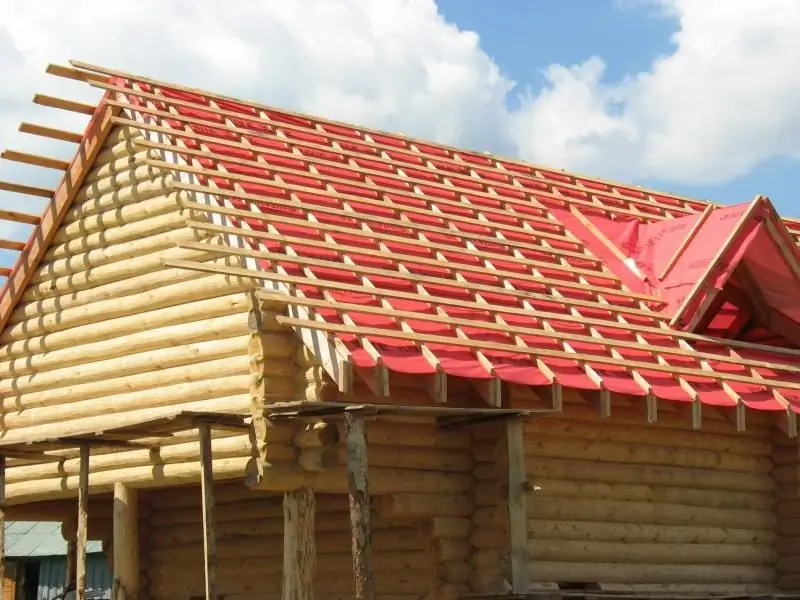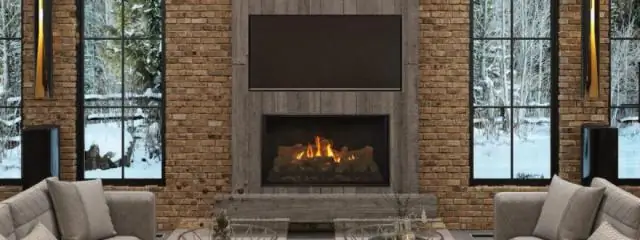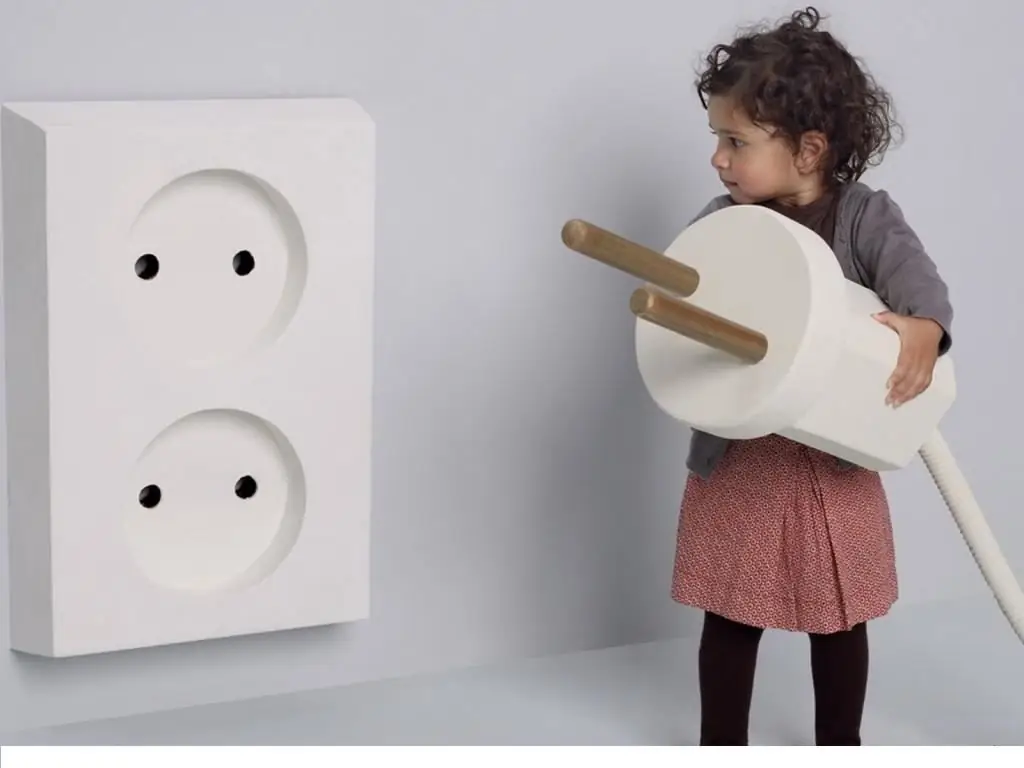
Table of contents:
- Author Bailey Albertson [email protected].
- Public 2023-12-17 12:53.
- Last modified 2025-06-01 07:32.
Do-it-yourself lathing for metal tiles: reliable, high quality, economical

The load-bearing capacity of the roof structure is of great importance for its durability. Therefore, high requirements are imposed on all elements, regulated by SNiP. This also applies to the lathing, which serves as the basis for the roofing. Its purpose is to hold the covering material, evenly distribute and transfer the load it creates to the walls and foundation. In this article, we will take a closer look at the device of the crate for metal tiles, the fastening of which is strictly regulated by the standards.
Content
-
1 Lathing for metal tiles: choice of material
- 1.1 Video: a template for installing a crate for metal tiles
- 1.2 Metal crate
-
1.3 Wooden lathing
1.3.1 Table: Comparison of wood species in terms of shrinkage rate and mechanical strength
- 1.4 Video: analysis of errors in the installation of metal tiles
-
2 Sheathing scheme
2.1 Video: installation of the crate for metal tiles
-
3 Calculation of the amount of material
- 3.1 Table: number of boards in 1 m³ (pieces)
- 3.2 How to save on lumber
-
4 The thickness of the lathing
- 4.1 Video: Inspecting and Sorting Planks
- 4.2 The most common lumber for lathing under metal roofing
- 4.3 Video: how to properly prepare a roof for metal tiles
-
5 Calculation of lumber for lathing for metal tiles
- 5.1 Calculation of solid lathing
- 5.2 Calculation of the sparse crate
-
6 How to make crate and lay metal tiles
6.1 Video: installation of lathing and metal tiles
Sheathing for metal tiles: choice of material
The lathing is a solid flooring (when the gaps between the rows of slats are not more than 1-2 cm) or a lattice structure laid on top of the rafters. A solid base is used when laying flat slate, roll materials, as well as metal tiles at the intersections of slopes, on the ridge, valleys, ribs and grooves. In other cases, a sparse crate is made.

When installing the roof, a sparse crate is made of metal tiles, except for the junctions of slopes, the passage of valleys and lines of cornices and ridge
Equip the crate in 1 or 2 layers. The first is mounted horizontally, parallel to the ridge. The second layer - for continuous flooring - is done in the direction from the ridge ridge to the slope or diagonally. To cover the roof with metal tiles, the first layer is quite enough. The lathing is wooden (made of beams or boards) or metal.
Video: a template for mounting a crate for metal tiles
Metal crate
The metal lathing is made of a special steel profile, which gives undeniable advantages over traditional solutions made of wood:
- free access to all structural elements;
- reduction of wind load by reducing the total area of the crate.
But this is not the main advantage of the metal profile. When constructing a lathing made of perforated steel pipes, the natural ventilation of the under-roof space and the drainage of condensate, the formation of which is inevitable due to day and night temperature changes in the off-season, is greatly improved. That is why the wooden crate for laying metal tiles is carefully protected from dampness. Meanwhile, even the best hydro and steam insulators deteriorate over the years and require replacement. And if this is not done in a timely manner, then the crate made of wood will rot with all the ensuing consequences. Alas, sad and costly.
This cannot happen with a metal profile crate. In addition, it is perfectly flat, which is important for a strong fastening of the covering material. The metal profile itself is convenient to transport and store, as well as simple and easy to install.

Metal crate for metal tiles has a lot of advantages, the main of which is to ensure good natural ventilation of the roof space
Hence the conclusion:
- the metal structure for metal tiles is not afraid of moisture, moreover, it retains its qualities in the most unfavorable weather conditions;
- internal rooms do without additional ventilation;
- the roof lasts longer and does not need to be repaired for a long time.
Wooden crate
Lathing made of wood for metal tiles is used much more often than metal. Although, in principle, there are no advantages over metal profile - neither in price nor in requirements for arrangement. Rather, it is the mentality, tribute to traditions and trust in the tree that affects. Before talking about wooden lathing, let's consider the structure of a metal roof. It consists of:
- rafter system and eaves;
- vapor barrier layer;
- initial crate;
- thermal insulation material;
- main crate and counter battens;
- waterproofing;
- metal tiles.

The structure of a metal roof consists of exactly the same layers as other roofs
As in the structure for laying any other roofing, here you also need to provide a gap between the metal tile and the waterproofing for ventilation of the under-roof space. Insulating materials are arranged in exactly the same order. For arranging a cold roof, a heat insulator is also not laid.

When installing a roofing cake of an uninsulated roof, you can do without laying a heat-insulating material, however, a waterproofing layer and a ventilation air gap are necessary
The only difference is that the sheathing step is made for a specific tile. That is, the structure of the lathing depends on the type of roofing and is stuffed under the acquired coating.
This individuality of the step is simply explained: different manufacturers and models - different sizes.

The pitch of the lathing should match the size of the shear wave of the metal tile
It is necessary to mention one more nuance - the first sheathing board is mounted above the rest by the size of the transverse wave of the metal tile. Usually it is 10-15 mm.

The first (cornice) row of lathing is made thicker than the rest by the height of the shear wave
Sometimes information slips that it is possible to make a completely continuous crate under the metal-tile covering. Indeed, sometimes they do. However, if someone thinks to save money on this and replace wood with cheaper materials, then nothing will work. We are not talking about any plywood, chipboard or fiberboard as a continuous flooring. Solid lathing for metal tiles means only a small step between the boards (up to 2 cm). So in any case, a natural tree is used, the breed of which the developers choose at will.
More often it is spruce, fir, pine, larch. In terms of price-quality ratio, it is preferable to use pine. It can be a timber or edged board with good drying and high performance. Saving on lumber is not worth it, so as not to make yourself unnecessary problems in the future.
Table: comparison of wood species in terms of shrinkage coefficient and mechanical strength
| Wood species | Shrinkage ratio,% | Mechanical strength for wood with 15% moisture content, MPa (kgf / cm 2) | ||||
| radially | in the tangential direction | for compression along the grain | bending | radial chipping | shear in tangential plane | |
| Coniferous trees | ||||||
| Pine | 0.18 | 0.33 | 43.9 | 79.3 | 6.9 (68) | 7.3 (73) |
| Spruce | 0.14 | 0.24 | 42.3 | 74.4 | 3.3 (33) | 3.2 (32) |
| Larch | 0.22 | 0.40 | 31.1 | 97.3 | 8.3 (83) | 7.2 (72) |
| Fir | 0.9 | 0.33 | 33,7 | 51.9 | 4.7 (47) | 3.3 (33) |
| Hardwood and soft-leaved trees | ||||||
| Oak | 0.18 | 0.28 | 52.0 | 93.5 | 8.5 (85) | 10.4 (104) |
| Ash | 0.19 | 0.30 | 51.0 | 115 | 13.8 (138) | 13.3 (133) |
| Birch | 0.26 | 0.31 | 44.7 | 99.7 | 8.5 (85) | 11 (110) |
| Aspen | 0.2 | 0.32 | 37.4 | 76.6 | 3.7 (37) | 7.7 (77) |
| Linden | 0.26 | 0.39 | 39 | 68 | 7.3 (73) | 8.0 (80) |
| Black alder | 0.16 | 0.23 | 36.8 | 69.2 | - | - |
Let's dispel another stereotype - allegedly metal tiles have the worst sound insulation. Some, because of this, refuse such a wonderful covering material. And completely in vain. Firstly, not a single roof gives a 100% noiseless result. And secondly, studies carried out by metal tile manufacturers have shown that the reason is not in the coating itself, but in the incorrectly assembled crate, errors in its filling and installation of the covering material. And also in a small angle of inclination of the slopes, saving on materials and self-tapping screws, which we will talk about a little later.
Video: analysis of errors in the installation of metal tiles
Even the type of wood for the structural elements of the roof does not play a special role. If the structure is assembled correctly and all stages of installation are done without violations, then the metal-tile roof will stand for a very long time, delighting with its beauty and good performance.

The species of wood for the lathing and rafter system does not affect the durability of a metal roof, the main thing is to make the installation without violations
Sheathing scheme
Before installing the crate, you need to decide on its type - solid packing or sparse.

A continuous crate for metal tiles is made only in the most critical places: on the ridge, valleys and junctions
When installing a solid sheathing, lumber is laid almost closely, leaving a ventilation gap of up to 2 cm. The grating is a little more complicated, but it is used more often, since its device reduces wood consumption and facilitates the roof structure. As for the step of the crate, then, as already written above, it should be equal to the wavelength. Many manufacturers indicate the necessary step in the instructions for the metal tile.
Often boards are sold already processed. But if not, then you have to do the impregnation yourself. This will dramatically increase the life of the wood.
-
The installation of the crate begins with the laying of the waterproofer on the rafters. Make a slight sagging and fix with a counter lattice.

Installation of waterproofing membrane It is better not to stretch the waterproofing film in order to leave it a little freedom with natural deformations of the roof frame
-
The lathing is fixed with nails 2 times the thickness of the board. They try to score them as close to the counter-rail axis as possible.

Fastening the battens to the counter battens The lathing is fastened to each counter-rail with two nails, which are driven into the edges of the board in the center of the lower bar
-
At the junctions, along the perimeter of the dormer and dormer windows, near the pipes, a continuous crate 15-20 cm wide and their own rafter system are mounted, to which the boards (beams) are attached.

Scheme of the lathing device at the junction points In places of roofing units, a continuous crate 15-20 cm wide is mounted
-
At the junction of the slopes in the zone where the valley passes, a ten-centimeter continuous flooring of the crate is laid along the entire slope with 2 cm ventilation gaps.

Diagram of the device of a continuous crate under the valley A continuous crate under the valley 10 cm wide is made along the entire slope
Particular attention should be paid to the first row of the crate (cornice row), since it is on it that all sheets of metal tiles are subsequently aligned. The thickness of the board of this row, as noted above, should be at least 10 mm larger than all other slats, which will smooth out the difference in the support points of the metal-tile sheets.

The correct arrangement of the eaves nodes is of great importance for the even laying of metal sheets and the organization of a normal drain
In addition, the step size between the first (cornice) and second row is always 50-70 mm less than the others. Measure it from the edge of the frontal board to the center of the next one. This indicator depends on the angle of inclination of the roof, protrusions outside the wall and the diameter of the downpipes and gutters. The step between the rows of the crate is calculated as accurately as possible, or it is made according to the recommendation of the manufacturer of the metal tile.
Video: installation of lathing for metal tiles
A crate filled not according to the rules for metal tiles will entail many defects in the roof:
- water will overflow through the gutter if the protrusion is larger than it should be, or, conversely, pass between the gutter and the frontal bar when the protrusion is smaller;
- the joining of sheets will be disrupted until it is impossible to connect adjacent elements;
- the fastening of metal sheets or fragments to the crate will weaken;
- it will be difficult to install and secure the end and pediment strips;
- air circulation in the under-roof space will be incomplete if the dimensions of the gaps are not maintained, which will cause the insulation to get wet, the appearance of mold and mildew.
Calculation of the amount of material
The amount of material required for the lathing device depends on the dimensions of the roof, the location of chimneys and other engineering and communication exits to the roof, as well as on the type of drainage system. Usually the crate is made of boards 6 m long, and their number is calculated by the step and size of the slopes. A known number of boards determine their volume.
Table: number of boards in 1 m³ (pieces)
| Board dimensions, mm | Volume of one board, m 3 | Planks in one cube (pieces) |
| 25x100x6000 | 0.015 | 66.6 |
| 25x130x6000 | 0.019 | 51.2 |
| 25x150x6000 | 0.022 | 44.4 |
| 25x200x6000 | 0.030 | 33.3 |
| 30x200x6000 | 0.036 | 27,7 |
| 40x100x6000 | 0.024 | 41.6 |
| 40x200x6000 | 0.048 | 20.8 |
| 40x150x6000 | 0.036 | 27,7 |
| 50x100x6000 | 0.030 | 33.3 |
When calculating, it is necessary to take into account the instructions of manufacturers for arranging a roof from one or another type of metal tile, which boil down to the following:
-
The gutter affects the size of the ledge. The typical size of the ledge is 30 cm, and when arranging the drainage system, another 30-40 cm is added to it.

Roof overhang The standard distance from the lathing from the wall is 30 cm, when installing gutters, it increases at least twice
- The starting point for measurements for calculating the materials of the crate is the frontal board (or the cut of the rafter legs, if there is no board).
- It is better to form air gaps with counter rails no more than 20 mm high.
How to save on lumber
- Use the discounts offered by lumber sellers and sawmill workers. There are excellent discounts in winter, since they cannot handle building materials that are not sold during the season.
- As the owner of a summer cottage or suburban area, acquire a felling quota from local self-government bodies and, after agreement with the forestry, bring the forest to the sawmill. Wood will come at a very low price.
- Purchase an edged board of a working section. Experienced builders have been using this technique for a long time to benefit the wallet. What is its essence: such a board is produced in the nomenclature like lumber produced according to Gosstandart 8486-86, but with a 5 mm smaller cross-sectional size. Its quality is commensurate with a board of the first grade, but due to the smaller section in one cube, the number of boards will be significantly larger. That is, 1 m³ of a working section board will cost about 15% less than buying a material made in accordance with GOST.
Crate thickness
Depending on the type and size of the roof, the following materials are used for the sheathing:
- for stuffing lathing on simple roof structures, which will be covered with metal tiles with a small wave and sheet thickness up to 0.45 mm, edged boards of 25x100 mm are used;
- for the device of the lathing of a complex roof or when using metal-tile sheets with a thickness of 0.5 mm with a high wave, they acquire material with a section of 32x100 mm;
- with a large rafter step, a bar of 50x50 mm or 40x60 mm is used.
Before starting roofing work, you need to inspect all lumber. Especially if it was purchased in a batch, where a deviation of about 5 mm between the thickness of the boards is a common occurrence. Calibrated and planed boards have more accurate dimensions, but it is expensive to use them for stuffing battens for metal shingles.

The purchased batch of boards may contain specimens with different thicknesses
Therefore, the first thing to do is sort the lumber according to size to avoid unnecessary problems during work. When sorting, decayed boards with cracks or irregularities are removed, as well as damp ones, which are dried to a standard moisture content of 19-20%. If the sorting is not done, then the difference in the thickness of the boards will lead to differences in level, which will make the installation of the covering material difficult and of poor quality.
Video: Inspecting and Sorting Planks
The most common lumber for lathing for metal roofing
-
Edged board with a thickness of 24-25 mm (24x100 and 25x100) - universal, but not too strong, it is used for simple roofs of light construction with an interval between rafters no more than 600 mm.

Edged board 25x100 Edged board 25 mm thick is used for simple and light roofs
- Board 32x100 - stronger in structure, well suited for sparse rafters with a pitch of 600-800 mm.
-
The tongue-and-groove board 25 and 32 mm thick for the device of a solid crate is beautiful, well-processed, durable, but expensive, therefore it is very rarely used for metal tiles.

Grooved board The tongue-and-groove board is used mainly for the arrangement of interiors, and for the lathing they are used very rarely due to the high cost
- A beam with a thickness of 50 mm (50x50) is used at a rafter pitch of 800 mm or more to protect the roof from deflection or with a heavy load on the slopes - in complex roofs with multiple structural and decorative elements.
Video: how to properly prepare a roof for metal tiles
Calculation of lumber for lathing for metal tiles
In order to avoid unnecessary costs, the calculation of the required lumber is done in advance. To do this, using a tape measure, the length and height of the slopes, the total length of all eaves overhangs, the total length of the valleys (if any) and ridge lines are measured.
Calculation of solid crate
The initial data for the example is a roof area of 50 m², used boards of 25x100 mm and a length of 6 m.
- Determine the area of 1 board - 0.1 (board width, m) x 6 (board length, m) = 0.6 m2.
- We calculate the number of boards - 50 (total area, m²): 0.6 = 83.33 ≈ 84 pcs.
- We calculate the required volume - 0.1 x 0.025 x 6 x 84 = 1.26 m³.
- We add a 10% margin for trimming, trimming and random errors. As a result, we get 1.26 x 1.1 = 1.386 m³ ≈ 1.4 m³.
Calculation of the sparse crate
The initial data are the same, the pitch of the lathing is 350 mm, the length of the cornice overhangs is 30 m, the length of the ridge line is 8 m, there are no valleys, a simple gable roof.
- We count the number of boards per lathing of the main roof area - 50 (total area, m²): 0.35 (step, m) = 142.8 linear meters. m: 6 (board length, m) = 23.8 pcs. ≈ 24 pcs.
- Determine the required volume 24 x 0.025 (board thickness, m) = 0.6 m³.
- We calculate the number of cubes for the arrangement of the ridge and cornices - 30 + 8 = 38 running meters. m: 6 = 6.3 pcs. x 0.025 (board thickness) = 0.16 m³.
- We calculate the total amount of lumber cubes - 0.6 + 0.16 = 0.77 m³.
- We add a stock of 10% - 0.77 x 1.1 ≈ 0.85 m³.
A more accurate calculation of the crate can be done using an online calculator on construction Internet resources or on the website of the manufacturer of the selected metal tile.
How to make crate and lay metal roofing
After the timber has been purchased, sorted, processed and the step has been determined according to the selected metal tile, they begin to fill the sheathing.
-
On the rafters, using self-tapping screws or nails, a sheathing of boards (timber) is attached, on which the waterproofing material is laid and fixed with counter-rails at intervals of 0.5 m.

Laying waterproofing The base is covered with a layer of waterproofing material
-
Edged boards of the selected section are stuffed transversely parallel to the ridge run. The cornice (lower) board is used 10-15 mm thicker than the others. At the same time, the distance between horizontal boards (crate pitch) is strictly maintained according to the profile wave.

Lathing fixing scheme When joining two boards on a counter-lattice bar, each of them is nailed separately
-
Near the ridge, two additional boards are fixed to the rafters with a distance of 5 cm between them. They will serve as a support for the ridge. A ridge bar is laid on top.

Installation diagram of a metal roof ridge The skate shelves must be at least 15 cm wide, otherwise snow will fall into the attic in the winter blizzard
-
After filling the lathing, they begin to fasten the metal tile.

Scheme of fastening metal tiles with self-tapping screws The metal tile is attached to the crate through the wave
You can check the correctness of the installation in the folk way - a test structure is mounted on the ground, maintaining the same angle of inclination, a sheet of metal tile is applied to it and watered with water. Too fast a flow of water will overflow the gutters, water will overflow and flood the foundation. A slow flow will lead to stagnation, damage to the boards and dampness of the roof space. Therefore, they choose the best option by increasing or decreasing the height of these rows and choosing an acceptable distance between them.

Checking the correct filling of the lathing will help to avoid overflow of water through the drain and prevent the foundation and outer walls from getting wet
To work you need the following tools:
- A hammer.
- Building level.
- Metal scissors and a hacksaw.
- Screwdriver.
- Roulette and building corner.
It is also necessary to think about the fasteners - galvanized nails Ø 3-3.5 mm and self-tapping screws, complete with washers to match the roofing and elastic seals. The best brands of self-tapping screws are Ferrometal and SFS, which can withstand extreme loads. It is advisable to use branded screws. Of course, they are almost twice as expensive, but the tightness of the fastening will be maintained.
To distinguish genuine fasteners from counterfeit ones, you need to squeeze the washer with pliers. On branded self-tapping screws, the gasket and the colored surface will remain intact. But on low-quality products, the seal will be damaged and the paint will peel off. Also, on counterfeit parts, the rubber gasket can be easily separated from the washer. The use of such fasteners will lead to leaks at the attachment points.
Leaks can also occur due to a violation of the vertical position of the self-tapping screw when it is screwed in and too close to the wave, as a result of which damage to the coating is possible

Correct fastening with branded fasteners protects the roofing from leaks and retains the warranty from the manufacturer of the covering material
The following self-tapping screws are used to fasten the metal roofing to the crate:
- metal-wood (self-tapping screws for wood) 4.8x28 mm or 4.8x35 mm (with high wind loads) - for fastening sheets to a wooden crate and for stitching sheets of metal tiles together;
- metal-to-metal (fastening to metal) 4.8x19 mm, 5.5x25 mm, 5.5x35 and 5.5x50 mm - for fixing metal-tile sheets to a metal base;
- metal-wood 4.8x60 mm, 4.8x70 mm and 4.8x80 mm - for laying Weckman tiles on wooden lathing and installing roof accessories - snow holders, valleys, aerators, ridge strips, etc.
In addition, any insurance company will refuse to insure an object where the quality of fasteners is in doubt.
Video: installation of lathing and metal tiles
The shelf life of the roof, its functional and operational properties depend on the correct construction of the lathing for metal tiles, as well as on the use of good materials. And this is calmness, coziness and comfort throughout the house. We hope that the information provided in this article will help make the roof of the house reliable and durable. Good luck to you.
Recommended:
How To Pinch Tomatoes Correctly In A Greenhouse And Open Ground (video, Photo, Diagram), Which Varieties Do Not Require Pinning

Practical advice for pinching tomatoes of different varieties. Pinion schemes for the formation of a bush in one, two and three stems
Do-it-yourself Metal Stove: Options From A Pipe And A Cast-iron Bath, Including A Diagram, Step-by-step Instructions With Photos And Videos

Types of metal furnaces, their advantages and disadvantages. Selection and calculation of material. DIY step-by-step instructions for building. Brick lining, chimney
Do-it-yourself Wood Stove - How To Make Economical Wood-fired Stove Heating, Device, Diagram, Drawing, Design With A Water Circuit, Reactive, Iron, Metal, For A Greenhouse + Video

Features and types of wood-burning stoves. Sizing and finding a place to install the oven. Do-it-yourself wood stove installation. Operating a wood-fired oven
Lathing For Monterrey Metal Tiles, Including A Diagram And Installation, As Well As How To Correctly Calculate The Amount Of Material

Sheathing device for metal tiles "Monterrey", the recommended dimensions and the scheme for calculating the required amount of sawn timber. Installation procedure
DIY Electrical Wiring: Diagram, Tips And Step-by-step Instructions For Installation From Scratch, As Well As Wiring Repair + Video

Practical advice on the installation of electrical wiring in an apartment and a private house. Wiring diagram. Installation of hidden and open wiring
